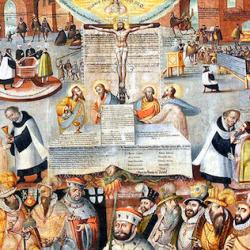Monks fled. They did not flee from community or contact with others. They fled in order to become more deeply engaged with others in a more radical form of community. Rowan Williams writes (Silence and Honey Cakes), “What is learned in the desert is clearly not some individual technique for communing with the divine, but the business of becoming a means of reconciliation and healing for the neighbour. You ‘flee’ to the desert not to escape neighbours but to grasp more fully what the neighbour is – the way to life for you, to the degree that you put yourself at their disposal in connecting them with God. The unusual community that is the desert monastery of the first generation is not meant to be an alternative to human solidarity but a radical version of it that questions the priorities of community in other contexts” (38).
At the heart of this radical form of solidarity is, Williams says, a rigorous application of Jesus’ command to “fear not.” This is manifest in the practice of “manifesting thoughts” to an elder: “The novice’s fugues and chains of fantasy or obsession are poured out, sometimes receiving only the harvest of acknowledgements and very little we would think of as counselling; but the job has been done, because the novice has been learning not to ‘follow’ the heart in the sense of taking what he discovers inside himself for granted, but to see the heart in all its complex, yearning, frightened actuality and to find words for it. . . . Defenselessness before the elder who represents God – that is the key to growth for the monks and nuns of the desert” (50).
This is not the sort of society we live in, which is “at once deeply individualist and deeply conformity. . . . We are fascinated by the power of the individual will and intensely committed to maximizing this power, the power to shape and to define a person’s life through the greatest possible number of available choices.” In this context, even religion can be an acceptable sort of choice that “enriches the range of the market.” But “we are actually so naive about choices, forgetting that the world of maximal choice is heavily managed and manipulated. The rebellious teenager has a ready-made identity to step into, professionally serviced by all those manufacturers who have decided what a rebellious teenager should look like; advertizing standardizes our dreams. Our choices are constantly channelled into conformist patterns, and when we try to escape, there are often standard routes provided by the very same market – ‘Don’t be like the crowd!’ says the advertisement which is trying to persuade you to do the same as all the other customers it’s targeting” (51-2).
The church is called to be a society of persons, not individuals, with specific gifts and callings, not conformed to one standard. It is to be a community “not only where each saw his or her vocation as primarily to put the neighbour in touch with God, but where it was possible to engage each other in this kind of quest for the truth of oneself, without fear, without the expectation of being despised or condemned for not having a standard or acceptable spiritual life.” Such a church needs “some very fearless people around” and needs to implement some “quite demanding forms of long-term spiritual discipline” (51). In short, “at the center of practically all [the desert fathers] have to say is Christ’s own command not to be afraid. Dying to the neighbour, refusing ot judge, the freedom to ask, like Abba Joseph, ‘Who am I?’ – all this is about freedom from fear” (34).
A community of the fearless is a community that resists conformity and individualism.















